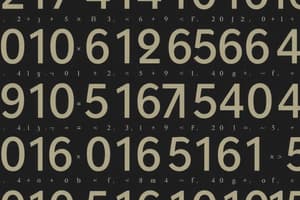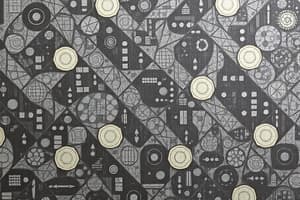Podcast
Questions and Answers
What is the common difference in the arithmetic sequence 3, 7, 11, 15?
What is the common difference in the arithmetic sequence 3, 7, 11, 15?
- 6
- 5
- 4 (correct)
- 3
Which formula represents a geometric sequence?
Which formula represents a geometric sequence?
- a_n = a + (n-1)d
- a_n = a * r^(n-1) (correct)
- a_n = a + d(n-1)
- a_n = r + (n-1)a
What is the next number in the Fibonacci sequence after 0, 1, 1, 2, 3, 5?
What is the next number in the Fibonacci sequence after 0, 1, 1, 2, 3, 5?
- 8 (correct)
- 7
- 6
- 13
What is the general form of an arithmetic sequence?
What is the general form of an arithmetic sequence?
If the first term of a geometric sequence is 2 and the common ratio is 3, what is the fourth term?
If the first term of a geometric sequence is 2 and the common ratio is 3, what is the fourth term?
How can patterns be visually represented to show their growth or decay?
How can patterns be visually represented to show their growth or decay?
Which of the following is NOT a characteristic of an arithmetic sequence?
Which of the following is NOT a characteristic of an arithmetic sequence?
What is the tenth term in the Fibonacci sequence?
What is the tenth term in the Fibonacci sequence?
Flashcards are hidden until you start studying
Study Notes
Generates Pattern Sequence
-
Definition: A pattern sequence is a series of numbers, shapes, or objects that follow a specific rule or formula.
-
Types of Patterns:
- Arithmetic Sequence:
- Each term increases or decreases by a constant difference.
- General form: a_n = a + (n-1)d, where:
- a = first term
- d = common difference
- n = term number
- Geometric Sequence:
- Each term is multiplied by a constant factor.
- General form: a_n = a * r^(n-1), where:
- a = first term
- r = common ratio
- n = term number
- Fibonacci Sequence:
- Each term is the sum of the two preceding ones.
- Starts with 0 and 1: 0, 1, 1, 2, 3, 5, 8, etc.
- Arithmetic Sequence:
-
Identifying Patterns:
- Look for consistent changes between terms.
- Analyze differences (for arithmetic) or ratios (for geometric).
- Recognize recursive definitions (like in Fibonacci).
-
Applications of Patterns:
- Problem-solving in mathematics.
- Predicting future values in sequences.
- Real-world applications in finance, nature, and computer algorithms.
-
Example Problems:
- Find the next term in an arithmetic sequence: 2, 5, 8, 11 (Answer: 14).
- Determine the first five terms of a geometric sequence: 3, 6, 12, 24 (Answer: 48, following 48).
- Calculate the 10th term of the Fibonacci sequence (Answer: 34).
-
Visual Representation:
- Patterns can often be illustrated with graphs or charts to show growth, decay, or cyclical behavior.
-
Practice:
- Create your own sequences and identify their type.
- Solve problems involving real-life scenarios where pattern sequences are applicable (e.g., population growth, savings accounts).
Pattern Sequence Overview
- A pattern sequence consists of numbers, shapes, or objects following a specific rule or formula.
Types of Patterns
-
Arithmetic Sequence:
- Features a constant difference between consecutive terms.
- General formula: a_n = a + (n-1)d, where:
- a represents the first term,
- d denotes the common difference,
- n identifies the term number.
-
Geometric Sequence:
- Each term is derived by multiplying the previous term by a constant factor.
- General formula: a_n = a * r^(n-1), where:
- a is the first term,
- r is the common ratio,
- n indicates the term number.
-
Fibonacci Sequence:
- Each term is the sum of the two preceding ones.
- Begins with 0 and 1, producing the series: 0, 1, 1, 2, 3, 5, 8, etc.
Identifying Patterns
- Check for consistent changes between terms.
- For arithmetic sequences, analyze the differences; for geometric, examine the ratios.
- Recognize recursive definitions, as seen in the Fibonacci sequence.
Applications of Patterns
- Useful for problem-solving within mathematics.
- Aid in predicting future values in various sequences.
- Have applications in real-world contexts, such as finance, nature, and computer algorithms.
Example Problems
- Next term in the arithmetic sequence 2, 5, 8, 11 is 14.
- First five terms of the geometric sequence starting with 3 are: 3, 6, 12, 24, 48.
- The 10th term of the Fibonacci sequence is 34.
Visual Representation
- Patterns can be illustrated through graphs or charts, showcasing growth, decay, or cyclical behaviors.
Practice
- Create personal sequences and determine their types.
- Solve real-life problems that involve pattern sequences, such as scenarios in population growth or savings accounts.
Studying That Suits You
Use AI to generate personalized quizzes and flashcards to suit your learning preferences.




